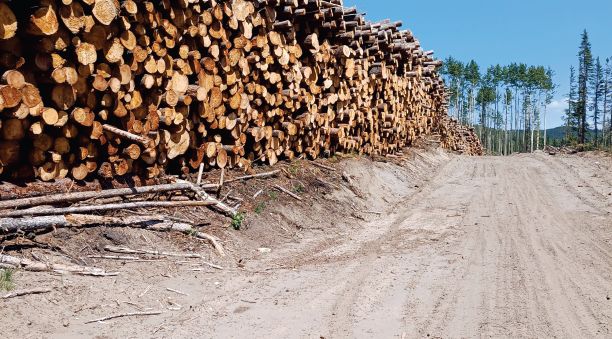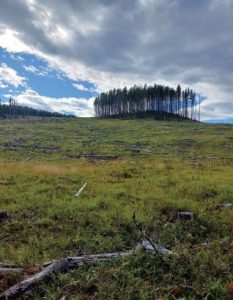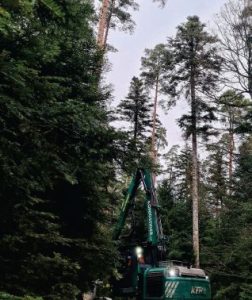
Forestry with a Difference: A Comparison between Germany and Alberta
January 20, 2025
- •
- •
- •
Despite the many differences, forestry plays an important role in both countries.
By Christin Spatz
Read the PDF version here.
The second largest country on the earth, with a diversity of landscapes and nature, wide areas with nothing but forests or open grassland and individual large metropolises, this is Canada. A country with a population of 41.6 M residents on nearly 10 million km2. The forest makes up 36.7 percent of the country and is mostly public land. In Germany, forests cover 32 percent of the land base and are mostly private. Germany, in the middle of Europe, is only 3.6 percent as large as Canada, but has twice the population.
Despite the many differences, forestry plays an important role in both countries. Because Canada is so big and diverse this article concentrates on comparing the province of Alberta and Germany.
A glimpse into the past
To understand why forest management in Germany and Canada, especially Alberta, is so different, we must look back in time.
Canada’s history of forestry, compared to German forestry, is still young. Although the Indigenous population already managed Canadian forests since time immemorial, the forestry that we know now in Canada started with colonialism in the early 17th century. Forests were lost through harvest or cleared for agriculture and residential sites. Expanded railways and bridges during industrialization in the 18th century led to a further loss of forests. Fires caused by engines also negatively impacted forests. A change was needed. The forestry profession that had already developed in Europe during this time was difficult to transfer to the expansive lands in Canada and the different social setting. Despite the missing support of politics and the public, the first forestry school in Canada was established in Toronto in 1907. Further schools followed until 1921. From 1900 to 1940 harvesting mainly happened in the Maritimes, Ontario, Quebec and British Columbia. That changed after the two World Wars when wood products like construction timber or paper became more important. Provinces such as Alberta and Saskatchewan, where industrial forestry was not yet established, became focused on timber production. Fire, diseases and insect outbreaks led to an increased awareness by the population of the environment starting in the 1960s. Even though some differences like the development of national parks were made, forest harvesting as it is done in most parts of Canada is still alarming, because of the heavy damage to ecosystems.
While in Alberta 90 percent of the forested area shows no impact of human footprint, the forests in Germany show traces of anthropogenic influences everywhere.
When the first settlements were established in Germany, it was covered in a mixture of deciduous tree species. During that time the European Beech (Fagus sylvatica) became the main tree species in Germany. In the early Middle Ages, 8th to 13th centuries, large parts of Germany were cleared of forests. Only areas that were unusable for agriculture or habitation remained as woodland. But still, these areas were influenced by humans. In addition to using forests for grazing, the production of firewood played a particularly important role. Various forms of management were developed for this purpose, resulting in a mosaic-like forest structure. In addition, leaf litter was used for stables. All these types of utilization led to a bald landscape, soil impoverishment, and acidification, which still influences forests in Germany. During this time, the English oak (Quercus robur), Sessile oak (Quercus petraea) and other deciduous tree species like European Hornbeam (Carpinus betulus) got promoted by the type of management and were able to regrow naturally.
As a reaction to deforestation, forestry educational institutions developed at the beginning of the 19th century, and laws were enacted or revised. For example, grazing in the forests was prohibited. Areas were reforested with Norway spruce (Picea abies) and Scots pine (Pinus sylvestris), which are domestic and fast-growing tree species in Germany. At that time, they were also planted in unsuitable areas, which caused unstable forests. In the 20th century the two world wars led to a further decrease of forest cover in Germany, because of destruction, higher utilization and war reparations. As a solution, a different kind of Poplar (populus) and the imported Douglas fir (Pseudotsuga menziesii) were seeded and planted. One result of this is labile and plantation-like forest stands.
Today extreme storm events, drought, and insect outbreaks, which increased due to climate change, are the biggest challenges for forestry in Germany.
Different ways to protect forests and nature
Currently a sustainable management plan for forests has become more important, and preventing deforestation is an essential goal for the public. While the primary focus of forest management is set on a sustainable yield in Alberta, Germany considers the aspects of recreation and environmental protection that forests provide as more important. To reach their goals Alberta and Germany have developed different practices and laws.
For example: Roads, built for clearcutting, are not permanent in Alberta. After the harvesting, timber companies must reclaim and reforest the roads within three years. A general rule while planning is to minimize the damage to the area by roads. Machines, such as the harvester, are allowed to drive over the complete clearcut area.
In contrast, Germany has permanent road nets that usually covers two percent of a hectare. The permanence is not only limited to roads but also to skid trails. These are trails normally 20 to 40 meters apart, on which heavy machines are allowed to drive into the forest stand. With this method the long-time compression caused by driving with heavy machines is limited, and the soil functions, such as water filtration, are still intact in the remaining area.
Weather conditions and using suitable equipment are considered by both countries. But Alberta has the advantage that the soil freezes in winter which it doesn’t in most parts of Germany. In this frozen state, the soil is less susceptible to erosion. Furthermore, the right-of-way limits the access for on-highway vehicles to forest roads, which exists in both countries and reduces wildlife disturbance.
Another interesting example of the differing practices by Alberta and Germany is how water is protected by law.
Alberta limits water crossings of forestry roads and has rules to prevent soil or other substances from getting into the water. For running waters that are fish habitat, a schedule of when crossing is allowed must be created with the help of an expert to prevent disturbance of fish populations. Wetlands should be avoided while harvesting and a forest buffer between 10 to 100 meters is created, depending on the type of water body. However, these rules have been criticized by environmental organizations and academics as not being strict enough to protect water.
In Germany, preventing soil compaction is one way to protect the water cycles in forests. In addition, areas with groundwater, water storage and water cycle regulation are protected by law. Certain activities that impact the functions of water protection areas are forbidden by law such as the use of chemical substances or clearcuts.
Harvesting impacts not only natural circulation processes but also wildlife and biodiversity.
Clearcuts have a big impact on the flora and fauna of forests. To reduce the negative impact, timber companies in Alberta must provide structure retention that has to cover three to five percent of the clearcut area. Structure retentions are single trees and small patches which should increase natural regrowth and offer a retreat for wildlife. Additionally, the access management for forestry companies should be based on protected areas for sensitive wildlife, like Key Wildlife and biodiversity zones, caribou ranges and grizzly bear access management areas. Considering those zones while planning is intended to reduce wildlife disturbance.
According to the nature protection law in Germany, forestry should aim to manage foresta without clearcutting and create a natural forest with local tree species. Areas with important habitats are protected by law and are associated with obligatory tasks for the owner, such as a traditional management plan. Selective harvest is allowed, as long as it isn’t destroying the ecological functions of the forest.
One of the biggest differences between Alberta and Germany is how clearcuts are used and allowed.
In Alberta, timber dispositions like Forest Management Agreements (FMAs) grant specific rights to timber harvest companies, that allow them to plan and carry out clearcut operations within their FMA area. The plans by the companies need the government approval and should consider the already listed regulations. Like Alberta, authorization is needed if an area bigger than one hectare is to be clearcut in Germany. As in Alberta, the areas must be reforested after the harvest.
One of the biggest differences is how clearcuts are defined. In the German federal state Baden-Württemberg, for example, an area is already a clearcut if the percentage of trees left standing is under 40 percent of the maximum possible number of trees. Also, the reason for clearcuts is different. While Alberta use clearcuts for extracting wood, Germany uses clearcuts to stop insect outbreaks, increase natural regrowth or to speed up the conversion of forest into a more suitable ones. Forests that protect water, habitats and steep slopes are not allowed to be clearcut for economic reasons in Germany.

Timber piled up on the side of a forest road at a fresh clearcut area in the Ghost Public Land Use Zone. Photo © C. Spatz
Clearcutting is not the only way!
In Alberta clearcutting is the most common way of harvesting. Areas of several hectares are harvested at once. Except for some single trees or patches, all the trees in the area are cut. An advantage of a clearcut site for timber companies is that it is a fast and easy harvest. But in addition to destroying ecosystems and important habitats, clearcuts also increase the risk of soil erosion, landslides and the decomposition of organic substances, which releases a lot of carbon. They disturb the water cycle and can change the quality of water bodies if the buffer around them isn’t providing sufficient protection.
How could Alberta’s forest management improve, and could it learn something from Germany? The silvicultural methods used in Germany are broadly diversified and create a variety of forest stands. Traditional methods are used to create both light and warmth in a forest with a high number of deciduous trees. In the past, the goal was to produce firewood, but now the focus is on protecting endangered species adapted to these kinds of forests.
Another traditional method, typical for small private forest stands, creates a dark and structure-rich forest. Different structures in age, species and height can be achieved with selective harvesting. With this diversity, the forest stand is more stable. A method that was the norm in the beginning of the 20th century is forest stands that are like a plantation. They were created from bare areas that were replanted in rows with a single tree species, mainly Norway spruce (Picea abies). This led to same aged, unstructured, and unstable forests.
In addition to the named methods, others have been developed with the focus on natural regrowth. One possibility is to cut older trees in such a way that holes are created in the upper stand through which light can reach the ground. This enables young trees to grow. This process is repeated until the holes are big enough, so that new trees can become established. The last adult trees can then be harvested. This type of harvesting leads to a forest area consisting of plants of different heights and ages. Depending on the tree species, the harvest of all adult trees is complete after 10 to 30 years. The duration, intensity of intervention and spatial distribution can transform a previously single-layered stand into a structurally rich forest.
Another method used in Germany for regrowth is instead of cutting an area of several hectares completely, the adult trees are harvested in smaller sections starting from one side. On the bare areas, young trees have enough light to grow. If sufficient regrowth has been established the next section can be cut. With this method, the negative impacts of clearcuts can be reduced and easy and consistent wood production is still possible. But forest areas managed like this are still unstructured and harvests are not concentrated in a short period.
What is the forest worth?
It cannot be denied that from an economic point of view, clearcutting as it is practiced in Alberta is one of the most efficient forms of timber production. But the question is: What is worth more? Forest products, or a forest that provides important habitats, produces oxygen and protects our drinking water?
Even though Germany must improve its forest management, it is clearly a step ahead of Alberta. One reason for this is Germany’s experience with the loss of intact forests. Furthermore, the German population shows a strong interest in how forests are managed and data about forestry is more transparent. Alberta, with some primary forests left, should learn from other countries’ mistakes. Alternatives for clearcuts do exist. The Alberta government and forestry companies only need to be willing to change and to be ready for compromises in harvesting methods and legal adjustments, for the betterment of the environment.
Christin Spatz was Alberta Wilderness Association’s summer intern student. Christin shadowed AWA’ staff and joined us on many adventures. She lives and studies in Germany.

